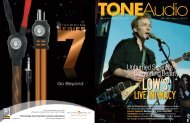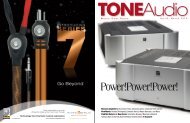Create successful ePaper yourself
Turn your PDF publications into a flip-book with our unique Google optimized e-Paper software.
REVIEW<br />
The individual percussion whacks of<br />
the Indigo Girls’ “Three Hits” rotate<br />
around the outside of each speaker,<br />
with the individual voices placed far left<br />
and right, and the magical harmony<br />
point placed well in front of the minitowers.<br />
Aerosmith’s classic “Dream On”<br />
is a stress-test song. Steven Tyler’s<br />
vocals can push many tweeters in<br />
the sub-$1,500 range into screechy<br />
crunchiness. Triton’s High-Velocity<br />
Folded-Ribbon (HVFR) tweeter keeps<br />
the high frequencies clear and dynamics<br />
strong. A testament to their driver<br />
design, the Sevens manage to keep<br />
even dense recordings well sorted.<br />
Tech and Setup<br />
Optimizing the Sevens takes very little<br />
effort. In my room, I achieve the best<br />
results using an equal triangular measurement,<br />
with the speakers toed-in<br />
directly to the listening position and<br />
placed four feet out from the wall. If<br />
you place the speakers too far apart,<br />
male vocals will hollow out and the<br />
center image will collapse. During<br />
setup, I suggest moving them apart a<br />
few inches at a time until you’ve gone<br />
too far, and then move them a touch<br />
closer.<br />
With an 89 dB sensitivity rating at<br />
8 ohms, the Sevens get jumping pretty<br />
easily. Though they thrive with the 150<br />
watts per channel of my reference<br />
Simaudio Moon i-7 integrated, the 35-<br />
wpc Vista Audio i35 tube integrated<br />
still delivers plenty of punch though<br />
with a slightly softer presentation than<br />
the Sim. These speakers are truly amplifier-friendly,<br />
as they work equally well<br />
with class-D amps. (continued)<br />
Compatible<br />
Predictable<br />
Optimized<br />
Yes, There Is a Best Cable for Your Speakers<br />
And, yes, you can find that cable. Or, you could—if you borrowed every<br />
cable ever made and used it in a bypass comparison. OK, so borrowing<br />
every cable is kind of a pain, but an easy bypass comparison is the only<br />
way to truly understand the “sound” of a speaker cable, or, better yet,<br />
to verify its desired neutrality, its lack of character or sonic signature.<br />
When we compare the sound of one component with that of another,<br />
we are almost always comparing one version of not-quite-right with<br />
another version of not-quite-right, and then choosing the component<br />
that seems most compatible with our system.<br />
However, true compatibility, with any one speaker or with every speaker,<br />
is only achieved by using the cable that does the least damage, allowing<br />
the music and its emotion to pass freely from the system to the listener.<br />
This is all about damage control: A cable can never improve the sound of<br />
the source, but the nature of what it does wrong makes all the difference<br />
in the world. For instance, in any system, a cable with a slightly soft focus,<br />
or “coloring” the sound like a neutral gray filter, won’t get in the way of<br />
the music. In an imperfect world, these are comparatively acceptable<br />
compromises. However, in any system, a cable that creates perceived<br />
resolution due to upper-midrange irritation, or a perceived bass boost<br />
that sacrifices midbass control and overall bass definition, does get in<br />
the way of the music. That kind of distortion is never acceptable.<br />
How can you distinguish a perceived short-term enhancement from<br />
real long-lasting quality It’s surprisingly easy! There are always multiple<br />
cables in the circuit path. There’s wire and/or circuit trace inside the<br />
amplifier, there’s wire inside the loudspeakers, and there’s a wire<br />
between the amp and speaker. If all three of these links are treated as<br />
constants, an additional speaker cable can be added between the amp<br />
and the existing speaker cable. The result will always be more damage<br />
and reduced sound quality, and, beyond that, the change will reveal the<br />
character flaws of the cable being evaluated. Whether the overall system<br />
is lean and irritating or fat and warm, this simple bypass test will reveal<br />
the nature of the evaluated cable.<br />
But, Which Path To Take<br />
If it’s that easy to determine a cable’s absolute character, or, better yet,<br />
verify its lack of character, then why does AudioQuest offer more than one<br />
series of cables Shouldn’t one cable or the other always be better<br />
or worse<br />
Yes and no. Context is everything. Driving inefficient speakers on the<br />
other side of the room is very different from driving a pair of desktop<br />
speakers close to the amp. As a baseline, it’s important to understand<br />
that all speaker cables cause sonic degradation that accumulates with<br />
length. Though several other distortion mechanisms are also cumulative,<br />
inductance, and its smearing of time integrity, is the primary culprit<br />
causing an increasing loss of focus.<br />
■ facebook.com/audioquestexperience<br />
■ twitter.com/audioquest<br />
■ instagram.com/_audioquest_<br />
A low-level audio interconnect doesn’t carry power and doesn’t have<br />
to manage strong magnetic fields, so we almost always recommend<br />
putting the amp as close as possible to the speakers and, if required,<br />
running a long interconnect. With a very few easy-to-predict exceptions<br />
(a few tube preamps, passive preamps, and low-input impedance amps),<br />
interconnect performance is far less susceptible to sonic degradation<br />
that accumulates with length.<br />
It’s About Power<br />
No, it’s not all about resistance (or impedance)! A normal 18 AWG lamp<br />
cord is rated to safely carry 10 amps—enough to kill you. Getting<br />
power to a speaker is easy. Getting it there undistorted is complicated.<br />
AudioQuest makes some very large speaker cables because diluting the<br />
energy and resulting magnetic fields across more metal is an effective<br />
brute-force way to reduce a number of distortion-causing mechanisms.<br />
The lower impedance of such large cables does allow some amplifiers<br />
to better “control” the motion of the bass driver. However, this effect is<br />
usually much smaller than the overall full-bandwidth improvement that<br />
results from causing less distortion within the cable.<br />
If all else is equal, and the sound is just enough louder for anyone<br />
to agree, “OK, that’s definitely louder,” then it’s probably about a 3dB<br />
difference, which requires twice as much power to the speaker. When<br />
each strand or conductor has to carry twice as much power, the interaction<br />
between any two internal elements is exponentially greater—that is, four<br />
times as great. Using a value of 1 for the lower power, the interaction is<br />
1x1=1, but for a signal that’s 3dB louder, the interaction is 2x2=4. If two<br />
different speakers are 3dB more or less efficient, and the volume is the<br />
same, the formula for internal cable interaction is exactly the same.<br />
The very effective Counter-Spiral Geometry of AudioQuest’s Tree Series<br />
is made possible by a bigger cable with more conductors. However, in<br />
the more moderately sized AudioQuest Flat Rock Series, the money that<br />
didn’t go into more metal and the more expensive geometry is used for<br />
higher-quality metal, making it possible for our Comet and Meteor Flat<br />
Rock models (fantastic in my desk system!) to take full advantage of the<br />
openness made possible by AQ’s PSS silver conductors.<br />
It’s Up To You<br />
So, while it’s still possible to tailor a cable to fit your specific needs, it is<br />
also possible to reasonably and rationally choose a cable that will bring<br />
you closer to your music.<br />
Sincerely,<br />
William E. Low CEO / Designer<br />
180 TONE AUDIO NO.64<br />
July 2014 181




